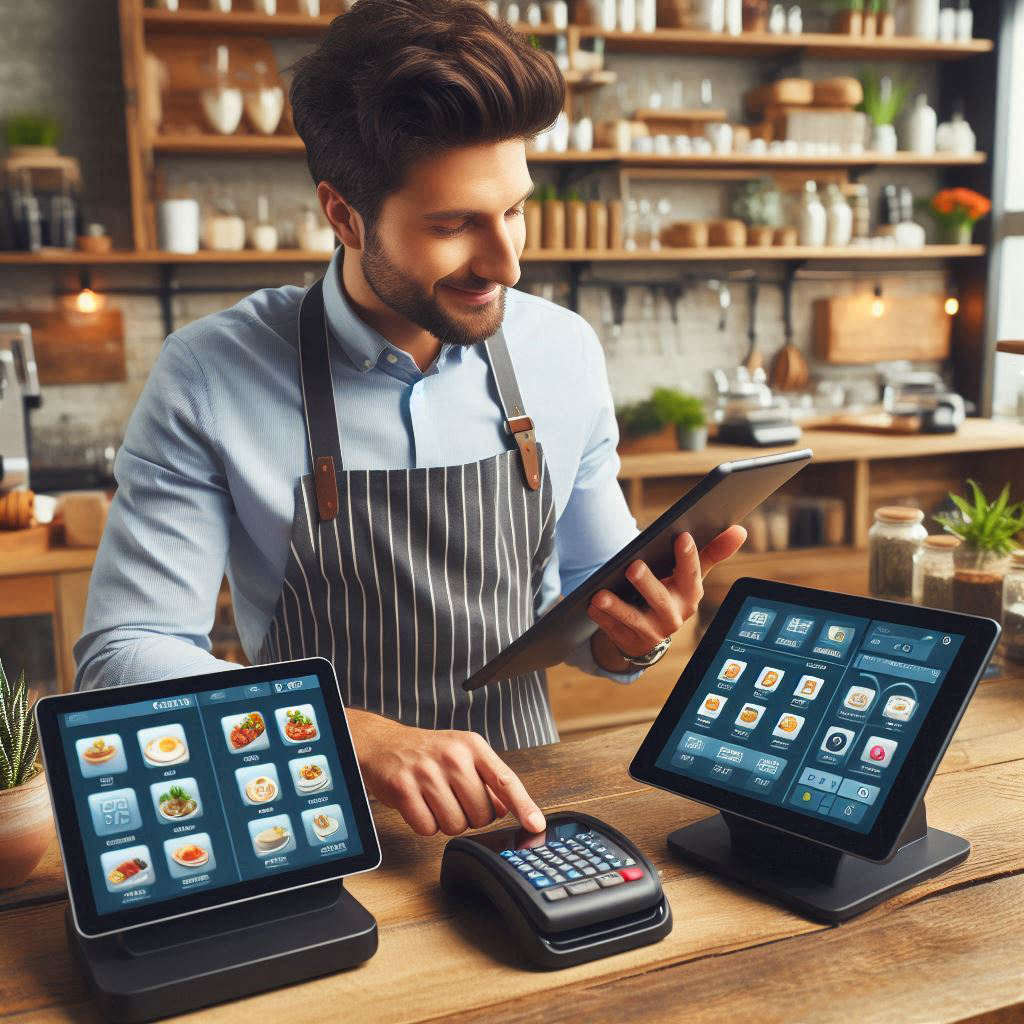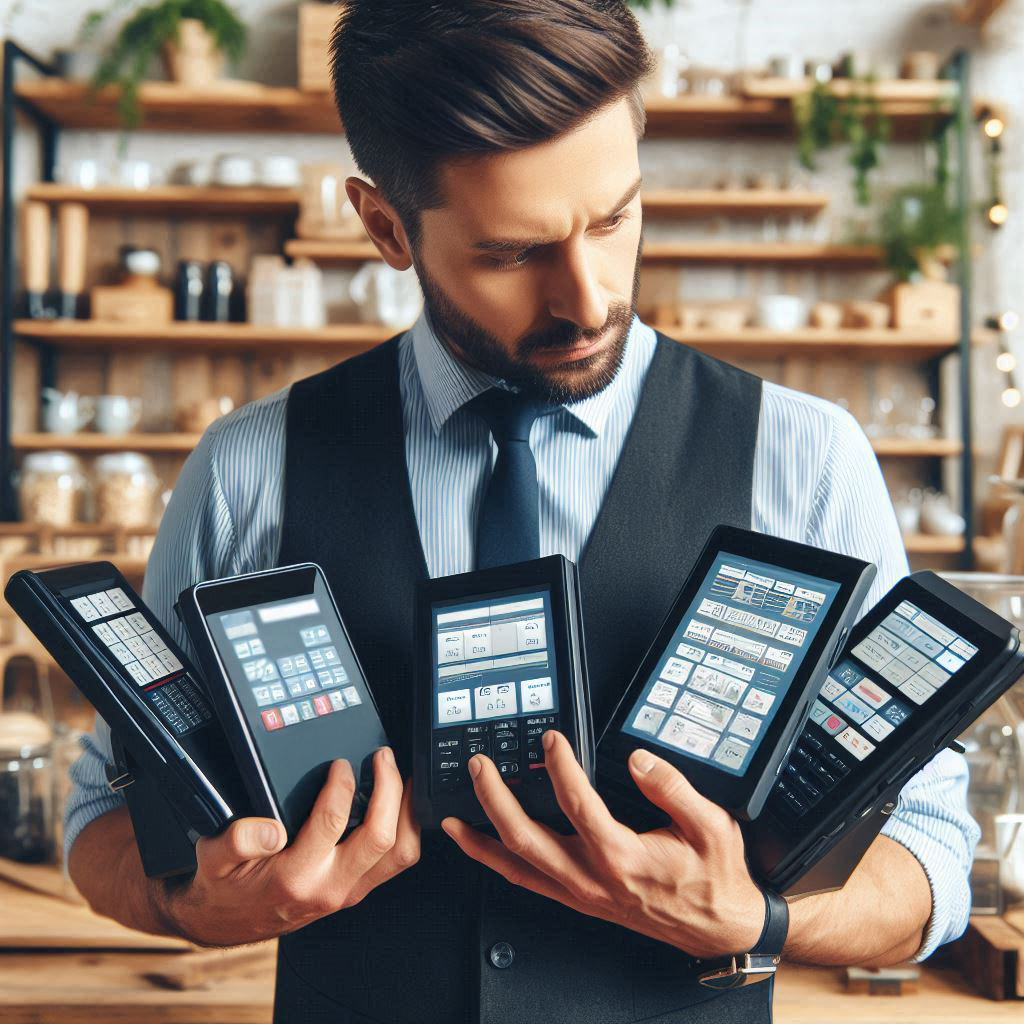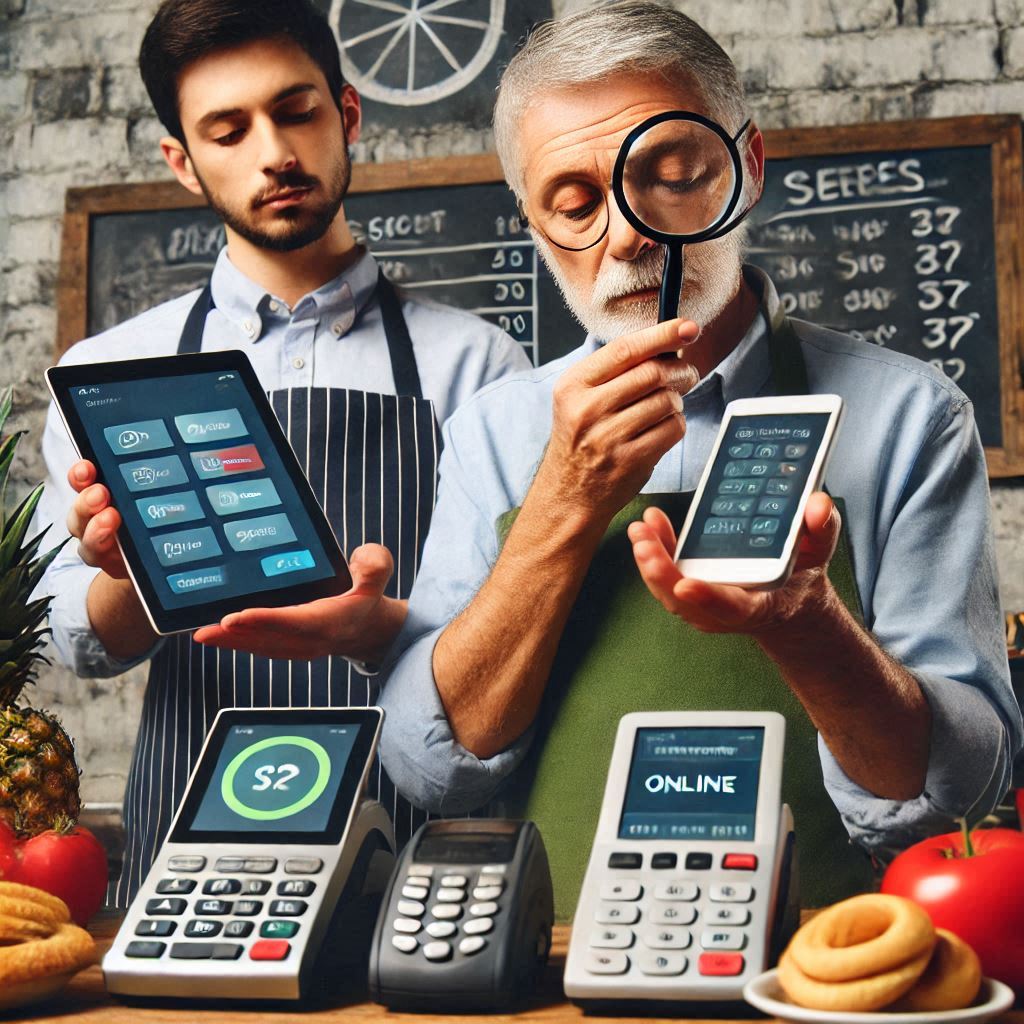13 Types of POS Systems for Restaurants
The Rezku Team

Point-of-sale (POS) systems have become essential for various businesses, serving as the backbone for managing sales and customer service operations.
Users can choose from an array of options, including mobile, tablet, and traditional POS systems, each of which offer unique features suitable for different business needs.
Among these, there are certain types of POS systems specifically designed for restaurants that are tailored to handle busy environments and intricate menus.
If you’re wondering what a POS system is in a restaurant and how it can transform operations, this guide will walk you through the options.
TL;DR Summary
- Restaurants can choose from multiple POS systems, including traditional, mobile, tablet, cloud-based, and self-service kiosks, each tailored to specific operational needs.
- POS systems streamline operations, improve customer experience through faster service, and enhance inventory management with real-time tracking and analytics.
- Selecting the right POS depends on restaurant size, service style, budget, and unique needs, making it a critical choice to maximize efficiency and satisfaction.
How Different POS Systems Influence Restaurant Operations
Different types of POS systems cater to unique business needs, so it’s important to choose one that drives efficiency and customer satisfaction for your restaurant.
If you’re looking for the best POS system for restaurants, understanding how these systems influence operations is vital.
Efficiency
A suitable POS system streamlines operations. Cloud-based solutions in particular offer real-time data access. This helps managers make quick decisions and address problems as they arise.
For businesses not tied to a traditional brick-and-mortar locale, mobile POS systems provide flexibility. They work well for food trucks and pop-up kitchens. Using tablets or smartphones, orders and payments become more accessible and convenient.
Customer Experience
A POS system affects how fast customers receive their orders. Systems with touchscreen capabilities, for instance, speed up order processing. That ensures customers receive their meals promptly, which then boosts satisfaction.
Inventory Management
Some systems track stock levels automatically. This is important for restaurants with large inventories, as automatic updates reduce the chance of running out of popular items.
Selecting the right POS system requires careful consideration of these factors. To learn more about implementation, you can explore how to use a POS system in a restaurant to ensure you’re optimizing your workflow.
13 Most Common POS Systems Used in Restaurants

In restaurants, POS systems boost efficiency and improve the customer experience. From traditional setups to modern mobile applications, each type of POS system has its own unique benefits and applications.
Traditional POS Systems
Traditional POS systems are hardware and software setups that include components like cash registers, terminals, and card readers.
These systems are known for their reliability since they operate offline and can handle high-volume transactions. They’re ideal for businesses with a steady customer flow that doesn’t require mobile flexibility. Many full-service establishments still rely on traditional POS systems to simplify order processing and payment collection.
Cloud-Based POS Systems
Cloud-based POS systems run on the internet and store data in the cloud, which translates to real-time data access and updates from anywhere. Restaurants use them for their flexibility and cost-effectiveness.
These systems can easily scale as a business grows, and updates are automatic so there’s less maintenance necessary. They’re particularly popular among small to medium-sized restaurants that require remote management of sales, inventory, and reports.
Tablet POS Systems
Tablet POS systems utilize tablets as the primary interface, providing mobility and ease of use. They typically come with a stand so they’re versatile for both counter and tableside services.
These systems are particularly useful in settings where space is limited, such as small cafes or pop-up locations. Their intuitive interfaces speed up transactions and provide a modern customer experience.
Mobile POS Systems (mPOS)

mPOS systems support flexibility through the pairing of smartphones or tablets with mobile card readers. They’re an asset for businesses on the go, like food trucks and market vendors.
The portability and convenience of mPOS systems make them a good fit for outdoor catering and events as well. These solutions enhance customer service by allowing payment processing to occur anywhere in the restaurant, in turn reducing wait times and increasing diner satisfaction.
Self-Service Kiosk POS Systems
Customers enjoy the ability to place orders themselves at interactive kiosks with self-service POS systems. These kiosks also shorten wait times and improve order accuracy.
They’re popular in fast-food restaurants and busy cafeterias, where speed and efficiency are critical. Customers can take advantage of order customization, and businesses can cut staffing needs during peak hours.
All-In-One POS Systems
All-in-one POS systems combine various components like card readers, printers, and displays into one unit. They’re compact and simplify the setup for restaurant operations.
Comprehensive systems are great for businesses looking to minimize space consumption and maintenance complexities. By having everything on one device, restaurants can clear the clutter and focus on providing better service.
Kitchen Display System (KDS) POS
A KDS system replaces traditional paper order tickets with digital screens in kitchens and improves communication between front-facing and kitchen staff.
This system is vital for managing order queues and ensuring dishes are prepared in a coordinated manner. Restaurants benefit from increased order accuracy and better workflow management, leading to faster service times.
Drive-Thru POS Systems
Drive-thru POS systems are specialized for quick-service restaurants with drive-thru lanes. They enable fast, efficient transactions using wireless headsets and display screens.
Critical for maintaining a smooth flow of traffic during peak hours, this type of solution allows staff to handle orders promptly. Customers enjoy better service thanks to quick order processing and shorter wait times.
Online Ordering POS Systems
Online ordering POS systems integrate with a restaurant’s existing setup to handle digital orders. They connect with websites and apps so customers can place orders remotely.
These popular POS systems are particularly important for expanding a restaurant’s service to include delivery and pickup options. They help manage a growing segment of the market so restaurants can reach customers who prefer online transactions.
Quick-Service Restaurant (QSR) POS Systems
QSR POS systems are designed for high-volume fast-food businesses. They’re tailored to process orders swiftly, manage queues, and reduce service times.
For establishments where speed is of the essence, QSR systems crucially accommodate combo orders and manage promotions efficiently.
Full-Service Restaurant POS Systems
Full-service restaurant POS systems cater to dining establishments with comprehensive features, including table management, reservation integration, and menu customization.
Such systems are instrumental in managing all aspects of the dining experience, from order entry to bill payment. They also improve service flow and allow staff to focus more on customer interactions.
Hybrid POS Systems
Hybrid POS systems combine the features of both on-premises and cloud-based systems. They operate offline and sync data online when connections are restored.
These solutions drive business continuity even during internet outages, making them suitable for diverse restaurant settings. Hybrid systems balance reliability with modern features, which appeals to businesses seeking a comprehensive solution.
Multi-channel POS Systems
Multi-channel POS systems integrate in-person, online, and mobile sales channels to manage orders across different platforms seamlessly.
They’re valuable for restaurants expanding beyond in-house dining to include delivery and takeout options. Consistent data tracking across channels enhances inventory management and customer insights.
Choosing the Best Type of POS System for Your Restaurant
When researching a POS system for your restaurant, you need to consider several major factors. The following list outlines critical elements that directly impact the efficiency and success of your business.
1. Restaurant Type and Size
The type and size of the restaurant play a crucial role in determining the right POS system. For instance, the needs of a quick-service restaurant, a fine dining establishment, or a food truck vary significantly.
While a large, multi-location chain would require a more robust, feature-rich solution with centralized management capabilities, a small café with a limited menu might benefit from a straightforward, tablet-based POS system.
In this case, Rezku is an excellent option thanks to its streamlined, tablet-based setup that handles payment processing, menu customization, and basic inventory tracking with ease. However, a full-service restaurant with a larger menu and multiple tables can also take advantage of the solution’s advanced features such as table management, online reservations, kitchen display system integration, and split billing.
Rezku offers scalable solutions that cater to different restaurant types and sizes, ensuring every establishment has access to the tools it needs to succeed. Additionally, Rezku provides features like online ordering, delivery integration, and real-time reporting, making it a powerful choice for restaurants looking to streamline operations and improve the customer experience.
2. Compatibility With Existing Systems
New systems should integrate seamlessly with your current hardware, such as printers, scanners, and card readers, as well as with software like accounting, payroll, or inventory management systems. That compatibility helps avoid costly replacements and operational disruptions.
For example, a restaurant already using QuickBooks for accounting might opt for Rezku, which integrates directly with QuickBooks to simplify financial reporting and functional consistency. Rezku’s ability to work with a wide range of hardware and software ensures a smooth transition and uninterrupted operations.
3. Ease of Use
A user-friendly POS system is essential for quick staff adoption and error mitigation.
Rezku’s intuitive interface is designed to minimize training time and support efficient service, even during busy periods. For instance, a fast-casual burger joint with high employee turnover might find Rezku ideal due to its simple touchscreen interface, streamlined navigation, and quick onboarding features. This ensures staff can hit the ground running with minimal disruption.
4. Budget Considerations
Budget is a key factor when choosing between various POS system types, as the total cost encompasses the initial investment, subscription fees, hardware expenses, and potential add-ons. Striking a balance between affordability and essential features is critical for long-term value.
Rezku offers flexible pricing options to fit a variety of budgets. A new restaurant with limited financial resources might start with its entry-level package that offers robust functionality at an affordable cost. Meanwhile, larger or more established restaurants can invest in Rezku’s advanced solutions, which include features like customer loyalty programs, delivery integration, and detailed analytics to support their growing operations.
5. Support and Maintenance
Reliable customer support and system maintenance are crucial for minimizing downtime and ensuring smooth operations.
Rezku provides dedicated customer support with 24/7 availability, helping restaurants quickly address issues and reduce downtime. For example, a busy 24-hour diner can rely on Rezku’s dependable troubleshooting and routine updates to keep their system running efficiently and ensure continuous service and satisfied customers.
6. Cloud-Based or Traditional
The decision between cloud-based and traditional POS systems depends on the restaurant’s infrastructure and specific needs.
Rezku possesses a flexible cloud-based solution that provides real-time access to data, automatic updates, and the ability to manage operations from anywhere. That’s ideal for food trucks or mobile vendors that require connectivity across multiple locations. For restaurants in areas with unreliable internet, Rezku’s offline capabilities ensure transactions continue seamlessly, syncing data once the connection is restored.
Final Thoughts on Types of POS Systems

Finding a POS system that fits your needs is critical for a restaurant’s efficiency and customer experience, as different options cater to various demands, such as mobility, scalability, or high-volume operations.
From traditional setups to modern cloud-based or mobile POS systems, each solution offers distinct features like inventory tracking, payment flexibility, and real-time analytics.
Restaurants must evaluate factors such as their size, service style, and budget to pinpoint a system that aligns with their operational goals. Armed with a well-suited POS system, these business ventures can enjoy streamlined workflows, higher customer satisfaction, and make business decisions.
FAQs
How many types of POS systems are there?
Several types of restaurant POS systems exist, each tailored to different business needs:
- POS terminal types are common in many businesses and are physically set up at a checkout counter.
- Mobile POS systems allow transactions via smartphones or tablets, offering flexibility in locations like retail floors or outdoor events.
- Cloud-based POS systems operate on the internet, enabling data access from anywhere, which is ideal for businesses with multiple locations.
- Self-service kiosks let customers complete transactions independently and are often found in fast-food restaurants or cinemas.
Understanding these options will guide you to select the system that best suits business operations and customer service needs.
What are the two most common operating systems for POS devices?
The two most prevalent operating systems for POS devices are Windows and iOS/Android:
- Windows-based systems are often used in traditional settings, such as restaurants and retail stores, due to their robust software capabilities and wide compatibility with other hardware. They provide a familiar interface and support numerous peripheral devices, which enhances functionality.
- iOS- and Android-based systems power many mobile and cloud-based POS systems. These are popular for their portability and ease of integration with cloud services, allowing for features like real-time tracking and seamless updates.
Businesses choose one or the other based on factors like budget, desired features, and system compatibility.
What’s the difference between a POS system and a POS terminal?
A POS system is the entire setup businesses adopt to process transactions and manage sales data. It includes both hardware and software components to enable a range of functions, from inventory tracking to customer management.
On the other hand, a POS terminal specifically refers to the hardware device used to complete sales transactions. That could be a traditional cash register, a touchscreen monitor, or a handheld device.
While the terminal focuses on the point of sale itself, the system encompasses all tools and services necessary for efficient business operations. Both are integral aspects of streamlining sales and customer service processes in modern commerce.
What are the best types of POS systems for retail?
For retail businesses, cloud-based and mobile POS systems are often the most beneficial.
Cloud-based systems boast flexibility with data access from any location, which is advantageous for businesses with multiple storefronts. They typically provide features like inventory management, sales reporting, and customer relationship management.
Meanwhile, mobile POS systems allow for in-store transactions away from the traditional checkout area, enhancing customer engagement and slashing wait times.
Retailers appreciate these systems’ seamless integrations with accounting software and eCommerce platforms, which make it easier to manage both in-store and online sales.
What are the different types of POS terminals used in restaurants?
Restaurants use several types of POS terminals to optimize their operations:
- Fixed terminals are the traditional choice, installed at specific locations like the cash counter or kitchen for taking and tracking orders. They’re usually robust and capable of handling large numbers of transactions.
- Handheld terminals are gaining popularity for table-side ordering, as they allow staff to take orders at the table and instantly send them to the kitchen.
- Self-service kiosks are another option that enable customers to place orders and make payments without direct staff interaction, speeding up service and allowing staff to focus on other tasks.
Each type provides unique advantages to improve restaurant efficiency and customer satisfaction.
Is Rezku the POS system you’ve been searching for?
Get a custom quote and start your free trial today.
Related Posts


